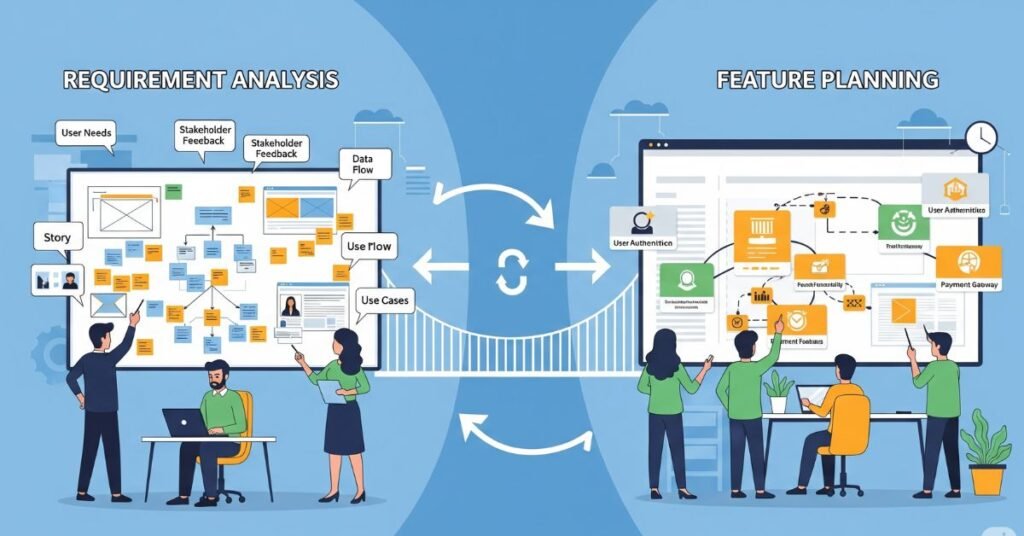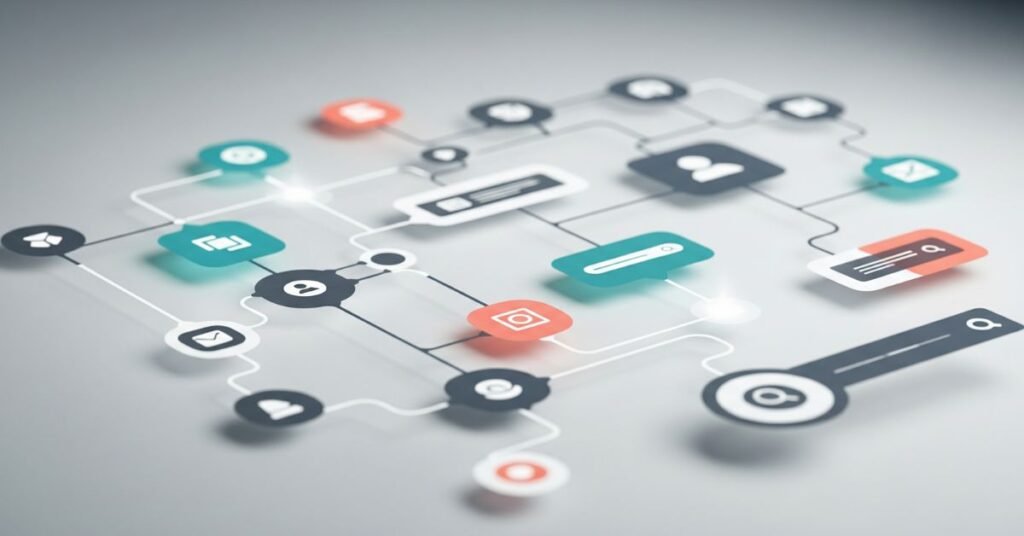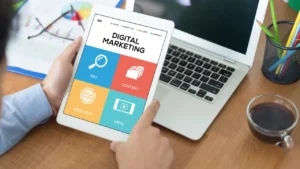So, businesses are asking how to develop a web portal today. It isn’t a website—it’s an online community space where people can go to get information, tools, and services from one location. To construct one, you must have well-defined objectives, sound design, strong tech, and frequent updates.
In this tutorial, we’ll guide you through each step of building a portal. You’ll learn how to design features, choose the proper tech stack, design great user experiences, and secure it. When we’re finished, you’ll know everything that goes into building a solid and lasting web portal.
Defining Objectives and Audience

The first step in developing a web portal is understanding why you need it and who will use it. Every portal has a specific role, such as customer self-service, employee collaboration, or e-learning. Without clarity, your project risks failure. That is why defining the target audience and business goals early is critical.
You must also decide on measurable outcomes. For example, an e-commerce portal may aim to increase conversions, while an internal portal may target better employee productivity. Having measurable goals ensures you can test success later. It also prevents wasted resources and helps align every part of development with real business needs.
You will like this: How Web Design Impacts Content Marketing
Requirement Analysis and Feature Planning

Once the purpose is clear, the next step is to identify which features your web portal should have. This is where requirement analysis becomes important. Businesses usually create documents that describe user stories or use cases. These documents explain what a user can do, how the system responds, and why that feature matters.
Features must be planned carefully. Common ones include login systems, dashboards, content management tools, file uploads, and messaging. Some features are essential for the launch, while others can be added later. A smart way is to create an MVP, or minimum viable product, and then expand in phases. This allows you to launch faster and still meet user needs.
Example Features for Different Types of Portals
| Portal Type | Key Features | Long-Term Additions |
| Customer Portal | Login, dashboard, support tickets | AI chatbots, advanced analytics |
| Employee Portal | File sharing, HR tools, messaging | Mobile app integration |
| E-commerce Portal | Product catalog, payment gateway | Personalized recommendations |
Choosing the Technology Stack

The technology stack decides how strong and scalable your web portal will be. For the front end, modern libraries like React, Angular, or Vue are common. For the back end, frameworks such as Node.js, Django, Laravel, or Spring are popular. The choice depends on your project size, budget, and future needs.
The database must also be chosen carefully. SQL works well for structured data, while NoSQL is useful for large, flexible datasets. Hosting options include cloud platforms like AWS, Azure, or Google Cloud. A scalable stack ensures the portal grows with your users. Security, speed, and integration support should also guide your choice.
Information Architecture and UX/UI Design

A web portal must have a clear structure so users can navigate without confusion. This is where information architecture plays a role. Developers create sitemaps and navigation flows to show how users move from one page to another. A strong design reduces drop-offs and makes the portal easier to use.
UI and UX design tools like Figma or Adobe XD help create prototypes. These prototypes are tested with users before final development. Design must focus on speed, simplicity, and accessibility. Mobile-first design is now a standard since most users access portals on phones. A clean, intuitive design leads to better engagement and satisfaction.
Read More: What is the Easiest Programming Language to Learn?
Development Workflow and Best Practices

Building a web portal is not a one-time job. It is a step-by-step process managed by frameworks like Agile or Scrum. These methods break the project into smaller tasks, so the team can test and improve as they go. Using version control systems like Git ensures code changes are tracked and managed safely.
Best practices include writing clean code, keeping modules reusable, and documenting everything. Integration with APIs allows portals to connect with other services. This is especially useful for payment gateways, CRM systems, or social media. Following industry best practices reduces errors and makes scaling easier later.
Security Implementation

Security is a major concern in web portal development. Portals often store sensitive data, which makes them targets for cyber-attacks. Strong authentication systems like OAuth, JWT, or single sign-on should be added. Role-based access control is also necessary when different users need different levels of access.
Data must be encrypted using SSL/TLS protocols. Passwords should be hashed before storage. Developers must test for common threats like SQL injection, XSS, or CSRF. Ignoring security can lead to serious financial and reputational loss. Building trust with users depends on having a portal that protects their data.
Testing and Quality Assurance

Testing ensures that your web portal works smoothly before going live. Different types of testing are used. Unit testing checks small pieces of code. Integration testing ensures different parts of the system work together. Usability testing checks if real users can navigate the portal without issues.
Load testing is also important. It tests how the portal performs under heavy traffic. Automated testing tools help reduce errors and save time. Bug tracking systems record issues, so the team can fix them before launch. Without quality assurance, portals risk failure, no matter how good the design is.
Common Testing Types in Web Portal Development
| Test Type | Purpose | Example Tool |
| Unit Testing | Checks individual components | JUnit, Mocha |
| Integration Testing | Verifies combined modules | Selenium, Postman |
| Load Testing | Measures performance under pressure | JMeter, LoadRunner |
| Security Testing | Finds vulnerabilities | OWASP ZAP, BurpSuite |
Deployment and Launch

Deployment is the stage where the web portal goes live. This involves setting up servers, domains, SSL certificates, and sometimes CDNs. Continuous integration and continuous deployment pipelines help automate this process. They ensure smooth updates without breaking the system.
Businesses often use a soft launch before a full launch. A soft launch releases the portal to a smaller audience for testing. Feedback is collected and fixes are applied. Once stable, the full launch can happen with marketing support. This step requires coordination between developers, IT teams, and business managers.
Post-Launch Maintenance and Upgrades

Launching a web portal is not the end. Regular maintenance is vital. This includes monitoring performance with tools like Google Analytics or New Relic. Logs and error reports must be checked often. Security patches and software updates should be applied quickly to prevent risks.
Over time, portals must scale to handle more users. That may mean upgrading servers, adding features, or improving speed. User feedback also guides future upgrades. Without maintenance, portals quickly become outdated and fail to meet modern standards. Continuous improvement is what keeps a portal successful for years.
Key Maintenance Activities After Portal Launch
| Activity | Frequency | Purpose |
| Performance Monitoring | Daily/Weekly | Ensure smooth user experience |
| Security Patching | Monthly/As needed | Prevent data breaches |
| Feature Upgrades | Quarterly | Improve functionality |
| Scalability Updates | Yearly | Handle more users and traffic |
Case Study Real-World Example

One example of successful web portal development is government e-service portals. These portals let citizens pay bills, apply for documents, and check status updates all in one place. The challenge was handling high traffic and security at the same time.
By using cloud infrastructure and secure login systems, these portals scaled to millions of users. Results showed faster processing, reduced paperwork, and better citizen satisfaction. This proves that with the right planning and execution, web portals can transform services and create value for both businesses and users.
Best Practices and Final Thoughts

When learning how to develop a web portal, some best practices stand out. Always focus on the user first. A portal that is confusing or slow will never succeed. Security should never be an afterthought. Start small with an MVP, then scale up as demand grows.
Finally, treat a portal as a living system. It will need care, updates, and improvements. The best portals are those that evolve with technology and user needs. A successful portal is not built once—it is built and rebuilt over time.
FAQ’’S
What is the difference between a website and a web portal?
A website shares information, while a web portal offers tools, services, and personalized access in one place.
How much does it cost to develop a web portal?
Costs vary depending on features, technology, and team size. Simple portals may cost thousands, while enterprise portals can reach hundreds of thousands.
Which technology is best for web portal development?
There is no single best. React and Angular are popular for front-end, while Node.js, Django, and Laravel work well for back-end.
How long does it take to build a web portal?
A basic portal may take 3–6 months, while larger portals may require a year or more. Time depends on scope, features, and testing.
How do you secure a web portal?
Use SSL encryption, secure authentication, hashed passwords, and regular security tests to prevent threats.
Conclusion
Now you understand how to develop a web portal from start to finish. It starts with setting goals, continues with planning and design, and ends with launch and constant upgrades. A web portal must combine clear design, reliable technology, and strong security to succeed. With proper maintenance, it can grow and evolve with time. By following the right steps, your portal will not only serve users but also bring lasting value to your business or organization.




